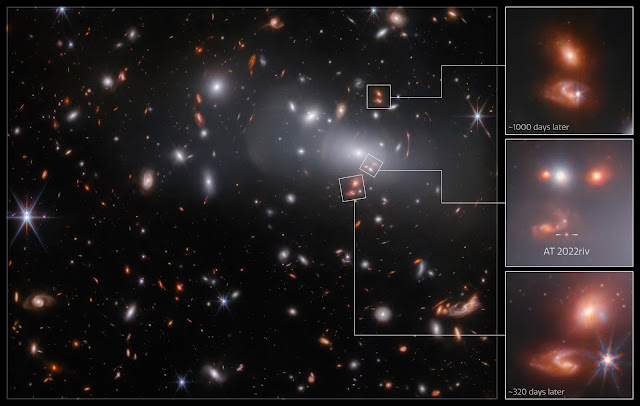Images of the distant universe captured by the James Webb Space Telescope continue to astound us and often exceed our greatest expectations.
This most current image from the space observatory fits well within that group.
The image in question shows a galaxy that often hosts supernovae at three separate times, all in one picture. Gravitational lensing, which results in the time-defying feat, happens when a large galaxy cluster, in this instance, a cluster called RX J2129 that is roughly 3.2 billion light-years from Earth in the constellation Aquarius, physically warps the fabric of space and time.
Depending on the route that the background galaxy's light went through or around the lensed object, the effect provides us with three alternative perspectives of the galaxy. We can still make out the supernova in the earliest perspective, when the light traveled the farthest. The supernova had already begun to fade in the second and third pictures, taken around 320 days and 1,000 days later.
The supernova, known as AT 2022riv, was initially seen by the Hubble Space Telescope and is a Type Ia supernova. These supernovae are known as "standard candles" because they consistently emit light at a particular distance, enabling astronomers to use them as cosmic yardsticks to measure distances in space.
Astronomers may see into the early cosmos by using gravitational lensing as a magnifying glass. A faraway galaxy whose light took more than 12 billion years to reach Earth was seen in one case from the year 2020 using this technique. In 2021, NASA also discovered a dozen "dead" galaxies using this approach.
Webb was launched on Christmas Day in 2021 and finally traveled almost a million miles from Earth to enter orbit around the second Lagrange point. In July 2022, the first full-color photographs taken by the telescope were released.
The annotated picture has been made available by the European Space Agency in a variety of sizes and resolutions on its website, several of which may be used as desktop wallpaper.
Referece(s):

"James Webb Telescope captures the same galaxy at three different points in time in a single mind-boggling image" is the title and then the last sentence in the third paragraph reads "The supernova had already begun to fade in the second and third pictures, taken around 320 days and 1,000 days later."
ReplyDeleteCan someone please explain how Webb could have taken those photos when it has not even been active long enough to take the first two photos? The first photo would have been 1000 days ago. The second photo would have been 680 days ago. As far as I know Webb was still in Florida.
Light from the subject took multiple paths to get to earth. Some took longer than others due to the massive object bending space-time.
ReplyDeleteThe time indicated, 1000 and 680 days respectively, represents the different points in time the gravitational lensing effect enables the same galaxy cluster to be displayed simultaneously. There is only one photograph, albeit with elongated apparature time. James Webb captured the single photograph of the cluster at 3 points in time, thus the "mind-boggling" reference.
ReplyDelete